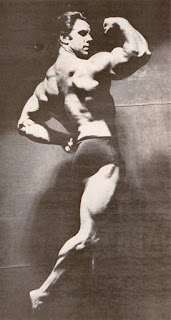Hail to the Dinosaurs!
Here are more questions I've been getting about
squats and related exercises. I thought I should
share them, because whenever one person emails
me with a question, there are probably several
hundred other trainees with the same question.
So let's get going!
Q. I've seen videos where trainees drop into a
deep squat and then bounce back up. Is that
the best way to do squats?
A. It's definitely not the way I do them! Dropping
and bouncing lets you handle more weight than
doing a squat with a controlled descent - but you
put your knees, hips and lower back at serious
risk every time you do a drop and bounce rep.
To me, it makes much more sense to use a little
less weight on the bar, perform your reps under
control, and aim to be lifting for the next 20, 30,
40 or 50 years - instead of hurting yourself and
ending up not being able to squat any more.
Q. I've read that squats stimulate your body to
produce more testosterone. Is that true?
A. Absolutely - and that's one of the reasons why
squats are such a remarkably effective exercise.
It's also why older Dinos need to keep on doing
squats - or to find alternate exercises for the legs,
hips and lower back if for any reason they can't
do squats. Leg training stimulates the production
of testosterone - and that's critical for older Dinos.
Q. Are Trap Bar deadlifts (or Trap Bar squats, what-
ever you call them) a good substitute for squats?
A. If possible, you should include both exercises in
your training program - but if you can't do squats
or you don't have squat stands, the Trap Bar is a
great alternative.
Many of our older Dinos can no longer do squats,
but they thrive on Trap Bar deadlifts.
Q. Can you give me any other good exercises to
use if I can't do squats?
A. I can do better than that. I covered this topic
in detail in a four-part series back in the Dec 2015
to March 2016 issues of The Dinosaur Files.
And I didn't just tell you what works for me as
an older Dino (although that was part of it). I
did way better than that.
Before running this series of articles, I asked the
Dinos for feedback - and got a ton of it.
Over 50 Dinos who can no longer do squats and
have had to find good replacement exercises sent
in responses - and the series includes all 50-plus
of them.
If you figure that each of those Dinos has an
average of 20 years of training experience (of
course, some have much more, and some have
less), that means this series gives you the
accumulated wisdom of over 1,000 years
of serious, no-nonsense, real world strength
training.
It's the most detailed series I've ever seen on
effective, real world alternatives to the standard
back squat - and on ways to work around age
related dings and dents or old injuries and keep
on training productively and effectively.
If you missed these the first time, around, I urge
you to grab them now - and study them closely.
I know that they will help you enormously.
These issues are all available in PDF format in
the PDF Products section of the Dinosaur Training
website:
http://www.brookskubik.com/products.html
The PDF's are printable, so you can print and save
them in your collection.
So if you're looking for real world information
on fun and effective squat alternatives - or on work
arounds for older trainees - look no further. We've
got you covered.
As always, thanks for reading and have a great
day. If you train today, make it a good one!
Yours in strength,
Brooks Kubik
P.S. If you're an older Dino, grab a copy of Gray
Hair and Black Iron - it's a must read for anyone
over the age of 35:
Gray Hair and Black Iron
P.S. 2. My new course on heavy partials is
selling like hotcakes - and readers are loving
it. Go here to grab a copy:
Dinosaur Strength and Power Course
No. 2 - Heavy Partials
No. 2 - Heavy Partials
P.S. 3. My other books and courses are right
here at Dino Headquarters:
Brooks Kubik's Hard-copy and PDF Books
For more hard-copy books and courses, visit: http://www.brookskubik.com/products.html
Brooks Kubik's Kindle Books
For even more Kindle books by Brooks Kubik, visit:























